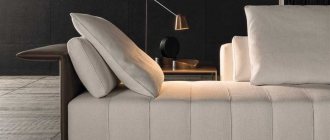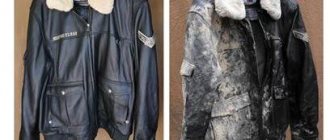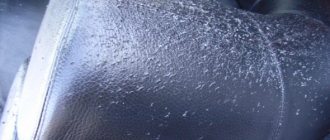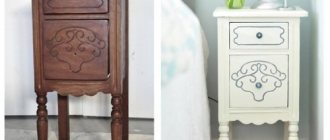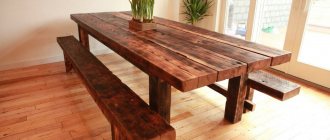Leatherette sofa repair: it all depends on the scale of the problem
The first thing to do is to assess the scale and nature of the damage. Typically, people need to tidy up their sofa upholstery for the following reasons:
- spots appeared on it;
- cracks, scratches or tears have appeared on it in one or two places;
- it had completely fallen into disrepair - it was worn out, large holes formed on it.
It is quite easy to deal with stains, scratches and small tears on a sofa made of leather, both natural and artificial. But doing a complete re-upholstery yourself is more difficult.
Shabby look
If your leather upholstery has worn out a little over time, don’t be sad, because you can fix it quite quickly. Before starting restoration, the surface of the furniture must be thoroughly cleaned of possible dirt and stains, because they are what add to the furniture’s unkempt appearance. After the furniture has been cleaned, the restoration site must be wiped with soapy water, and after it has dried with 70% medical alcohol. Then you will need paint, with its help you can disguise small scratches, cracks and even out the color as much as possible. This leather dye can be purchased at any furniture store. It is best to take the paint in spray form; it will be more evenly distributed over the abraded skin.
Minor sofa upholstery repair
If we are talking about cracks, severe abrasions and other damage to the artificial leather surface, the detergent, of course, will not help. To prevent the gap from getting larger, its edges can be sealed with tape. But this is a temporary measure, and such repairs to the sofa upholstery don’t look very nice. How to restore artificial leather so that the damage is not noticeable at all?
If you have material in a suitable color, use it. How to seal a damaged area? Just cut out a piece of the desired shape and size, spread it with superglue, carefully apply it to the tear site and press.
What if you don’t have the material in the right color?
If the scratch or tear is not very large, you can use special paints or aerosols. All you need to do is apply this product to damaged skin and wait a little for it to dry. To achieve the required thickness, apply paint or spray in several layers, but be careful not to leave unsightly streaks on the surface.
Entire kits for restoring damaged artificial leather are on sale today. They include:
- several jars of paints of different colors;
- pieces of fabric that differ in texture;
- spatula for applying a suitable product.
Such kits are usually intended for car owners who need to tidy up the seats in their car. But they are also suitable for repairing a sofa in your living room or bedroom.
Another tool that will be useful to you is “liquid leatherette.” It is an alcohol-based polymer. Use it to repair sofa upholstery as follows:
- you need to take a piece of bandage or gauze corresponding in size to the site of injury;
- apply it to the damaged area;
- apply the solution to it using a spatula;
- wait 10-15 minutes until it dries.
Recommendations for caring for leather furniture
If you follow a few simple rules, you can avoid damage to leather furniture. The main condition for the safety of furniture made of genuine leather is the best microclimate. Such furniture should be placed no closer than 1.5 meters from the heat source, and the optimal humidity level will be from 65 to 70%. Every year it is worth cleaning the coating 2-3 times using a special conditioner or taking it to dry cleaning. Impurities from the surface of the skin should be removed immediately, as once they are absorbed into the pores it will be difficult to remove them. In order to remove stains and perform regular maintenance, special furniture wipes are used. If you use alcohol, oil, or soap solution to clean furniture made from genuine leather, the material will dry out very quickly and the structure will begin to deteriorate (cracks will form on the surface). To clean a sofa or chair, you should use special products.
In order for the product to remain intact, it should be treated once a month with a protective spray or wax, which will reduce the degree of hygroscopicity and porosity of the material. If the water in your house is hard, then you should never use a dampened rag to care for furniture. This will lead to the formation of plaque on the skin, the material will lose its elasticity and become rigid. You should also avoid bringing your light-colored sofa into contact with dyes, including clothing such as jeans. You should not use organic solvents such as white spirit and acetone for regular cleaning. With such compositions it is impossible not only to clean natural leather, but leatherette furniture will also lose its paint and protective layer, and stains will appear on the varnish surface.
Sofa upholstery repair: complete reupholstery
To completely reupholster furniture, you will need a lot of material. In addition, it is necessary to completely remove the upholstery from it and make new parts based on its sample, after first removing the pattern from the old ones. This is a time-consuming task, so it is better to order the appropriate service from professionals.
Now you know how to repair a damaged sofa, and we hope that our tips will be useful to you.
Eco-leather is a universal material used in the production of haberdashery goods, clothing, shoes, furniture and car seat covers. The material is made by applying a porous polyurethane film to a cotton base. The elastic film is absolutely non-toxic, safe, breathable, but its service life cannot be called long.
Cuts
Dealing with cuts on leather furniture is a little more difficult than dealing with a regular abrasion or scratch. But this does not mean that it is impossible to correct the situation. In this case, a patch will help you. The material from which it will be made is not so important, the main thing is that it is dense and elastic. You will need tweezers, with which a patch slightly larger than the cut must be placed under the top layer of the leather covering of the furniture, then take a toothpick, dip it in special leather glue and with a precise movement, spread the adhesive on the inner surface of the leather around the cut. After this, gently press the skin onto the patch, while clearly aligning the edges.
How to restore eco-leather
Gloves, a purse, a business card holder that have lost their shine and color saturation are wiped with fresh orange peel. But keep in mind that the product will fade again in just a week. Grease stains are perfectly removed by dishwashing detergents. Drop a little product onto a damp sponge and wipe the contaminated area with it.
The gel can be washed off immediately or left for several hours. Gasoline or turpentine helps fight stubborn stains. Professional paints for artificial and natural leather perfectly renew the color. The coloring pigment literally penetrates into the structure of the fabric.
The main advantage of this method is the rich color palette: from neutral colors to acidic shades. Transparent varnish is used as the finishing layer. Aerosols paint over areas with peeling paint, fill small scratches and smooth out the surface. The product should be applied in the thinnest layer: a large amount of paint is the main reason for the formation of smudges and cracking of a freshly painted area.
Important! Aerosol paints should be sprayed at a distance of 20-30 cm.
Methods and materials
An alternative to aerosols and professional paints is liquid leather. The product contains an adhesive base, dyes and rubber resin.
Liquid leather creates a so-called leather relief on the surface. Ideal at first glance, the material has its drawbacks. For example, it is only suitable for filling scratches, cuts and punctures. It will not be possible to patch a large gap.
Difficulties also arise when choosing the right shade. Rare colors are obtained only by mixing primary tones. During work, you must strictly follow the instructions and not neglect the basic laws of color. It is unlikely that you will be able to choose an unusual color palette with a predominance of golden and silver shades.
Manufacturers offer only classic colors: black, white, red, green, blue, yellow, brown, gray. Liquid leather recreates both glossy and matte textures.
What to look for when doing your own repairs and choosing materials
The main thing in restoring eco-leather is recreating the relief pattern. It is better to paint over a small area (no more than 1 cm2) with a brush. The surface is pre-degreased for better adhesion of the eco-leather to the polymer material. The place of puncture, cut, or scratch is cleaned of protruding fibers of fabric and glued with gauze from the inside.
Liquid leather is applied in two stages: first, a very thin first layer, then a second layer, applied after two to three hours. Restored eco-leather dries completely within 24 hours.
This method is only suitable for perfectly smooth surfaces. An ordinary napkin on which liquid leather is applied will help to recreate the relief. The napkin must be applied to the entire area with a clearly embossed pattern, and then dried for ten hours. This blank will serve as a template for creating natural irregularities.
The napkin should be applied only after applying two layers. You can get an imprint using a piece of natural or artificial leather, which is cut from old shoes or gloves.
Attention! Never apply liquid leather in a thick layer.
What you will need
- Leather repair kit (recommended)
- Large needle or toothpick
- Superglue or leather glue
- Fine-grit sandpaper (with a grit value of at least 320)
- Palette knife
- Tweezers
- Clean sponge or soft cloth
- Leather cleaner or 70% isopropyl alcohol
- Crack filler for leather
- Material for internal patch
- Hairdryer (optional)
- Leather paint and topcoat (if required)
How to restore eco-leather on a sofa
Leather furniture looks impressive and stylish. People are increasingly refusing to buy expensive sofas and armchairs upholstered in natural leather due to high costs and ethical principles. An inexpensive alternative has become eco-leather, which in appearance is practically no different from natural leather, and in some respects even surpasses it.
Liquid leather is rightfully considered the best material for the restoration and restoration of ecological leather. The polymer material fills cracks, cuts, marks from teeth and claws.
Restoration work is carried out in several stages:
- the surface is leveled, threads and fibers are removed;
- the edges of the cut or hole are carefully stitched or glued from the inside;
- eco-leather is wiped with liquid detergent and dried;
- the desired shade is selected by mixing several basic colors;
- liquid skin is applied with an art brush or foam rubber;
- The repaired sofa is left to dry for a day.
Attention! You can remove smudges and level the layers using a student’s ruler or ordinary plastic card.
How not to ruin your sofa completely
If abrasions and damage occupy a large area, then the furniture cannot be restored. It is also unlikely that a sofa upholstered in eco-leather in an exotic color (light green, turquoise, coral, terracotta, lilac) will be able to return to its original appearance. At home, it will not be possible to recreate a complex and ornate design using a napkin or a piece of old leather.
Elimination of defects using “Liquid Skin”
- Purchased in a store or market, the color is selected to match the upholstery;
- Degreasing the defect; for this you can use an alcohol solution, moisten a cotton swab in it and wipe the desired surface;
- Laying the material itself at the site of damage;
- Pressing down on top with a clean napkin;
- Walk over the sealed area with an iron.
With an ideally selected shade, not a trace remains of the hole, since the “liquid skin” begins to melt when exposed to high temperature, in our case this is an iron. After melting, all the smallest areas of the defect are filled, making the upholstery look like a solid covering.
Required materials and tools
To choose the right materials, you should carefully evaluate the condition of the furniture. This is necessary to understand the nature of the problem and determine how to fix it. To repair leather furniture, you may need professional tools that are not advisable to buy for one-time home use.
If we are talking about simple contamination, then it will be enough to prepare a cloth and alcohol. Repairing cracks is a little more complicated. Before starting work, you will need to acquire construction tools - they will be used to dismantle furniture and remove old upholstery.
This is a set of screwdrivers, wrenches, screwdriver, pliers, staple removal tool. Changing the material involves using a staple gun. This is a basic set of tools.
There are repair options using paint, liquid leather and other improvised means. Therefore, it is worth purchasing them in advance. Don't forget about the sofa's filling - the material may also need to be fully or partially restored. Foam rubber is often used as a filler. You definitely need to get some thread and a needle. A sewing machine will do the job faster. If you plan to partially or completely replace the upholstery, then a large amount of new material will be required.
Deodorization
But eco-leather also has one advantage compared to natural leather. Animal skin, of course, has pores. And when the skin no longer covers the animal, but your sofa, these pores turn into holes that let all the smells through the upholstery. So, over time, the sofa can change its noble smell of leather to the smells of food, tobacco, or a mixture of both.
But for cleaning and deodorizing leather furniture, there are now many products on sale, which, however, you can replace with folk recipes. To kill bacteria, wipe a sofa, chair or other piece of furniture with white wine vinegar - it is the least dangerous in terms of unpleasant odors.
And to keep your skin soft, shiny and smelling delicious, wipe it with a scented oil, such as orange tree oil. For those who do not like strong odors, olive or flaxseed oil are suitable. To prevent the leather from drying out, like solid wood furniture, maintain a normal temperature and humidity level in the apartment. This is beneficial not only for your things, but also for your own body.
Repair and restoration methods
For leather furniture, stains are not as critical as physical defects such as cuts or scratches. There are several main methods for restoring such furniture, aimed at both full or partial restoration of the material and hiding defects. The upholstery will not look the same as before, but the scratches will be invisible. The following repair methods can be noted:
- The easiest way is to repair leather furniture using a product called “Liquid Leather” or its equivalent;
- The scratch is painted over with varnish or paint matched to the color of the upholstery. Here we are talking only about camouflage;
- An applique is applied to the damaged area or a patch is sewn on if this does not affect the appearance of the product;
- The most difficult and time-consuming process is the complete re-upholstery of the material. You should resort to it only when repairs with liquid leather no longer help;
- Replacement of accessories. In some situations, it is not the upholstery itself that needs repair, but decorative elements or fittings.
Liquid skin
If you have to work with major damage, you will need to fill the void with foam rubber or cotton wool. This area is glued from the inside of the upholstery. Using the table supplied with the liquid leather, you should select the most suitable color.
The damaged surface is cleaned, degreased, after which the leather furniture is repaired with your own hands. There are no special rules for applying “Liquid Skin” to the surface. The liquid can be applied either with a brush or with a spatula. There is a trick that allows you to give the area restored using the specified product the texture of the original material - you need to attach a sample from the sofa to the damaged area.
Video
Did you like the article? Follow new ideas from the world of construction, design, and useful tips in our channel. Subscribe to us in Yandex.Zen. Subscribe.
When choosing leather furniture, you should know that genuine leather is considered a more practical material than ordinary fabric. It is durable, non-staining, elastic, pleasant to the touch, and has a long service life. But, unfortunately, even such upholstery does not last forever and tends to lose its original appearance. No matter how carefully you treat leather furniture, sooner or later the product may take on a shabby and aged appearance.
Owners of leather furniture quite often encounter scratches, cuts, various holes and other defects that spoil its surface. The ideal option would be to reupholster the old covering, but it is worth remembering that this is not a cheap pleasure and in some cases it will be easier and cheaper to carry out minor repairs with your own hands. It is for such cases that the most common cases of defects and methods for dealing with them were selected /
Scratches
Scratches or snags are damage when only the top layer of skin is affected, and it is separated from the bottom layer in a narrow strip. This strip just needs to be glued in place:
- When purchasing leather furniture, a special repair kit is usually included, which, in addition to patches and paint, also includes glue. If you do not have this repair kit, then you need to purchase leather glue.
- Some people suggest using superglue. It is suitable for natural leather, although after it you will need to sand the surface of the scratch.
Important! When using superglue, keep in mind that the part of the skin that was in contact with the superglue will become hard, and if you do not wipe off the remaining glue from the front surface in time, it will also be covered with a white coating.
- To remove the snag, you need to degrease the damaged area with medical alcohol and wait a little until the surface becomes dry.
- Now, using a toothpick or a very thin brush, apply glue to the back of the hook and carefully place it in the desired place, leveling it with your finger in the direction from the base to the end of the hook.
- After all manipulations with glue, be sure to remove any remaining glue from the surface with a paper napkin.
- Do not use the sofa until the glue has completely dried.
Important! See the label for the time it takes for the composition to dry. It is also not advisable to use a hairdryer to speed up the drying of the glue. Let it dry at room temperature.
Usually this manipulation is enough to make the scratch invisible.
Tears, holes
How to repair a hole in a leather sofa? If the furniture has suffered more serious damage - a hole has been burned by a cigarette, a hole with uneven edges has broken through, etc., the best restoration option would be repair using the so-called “liquid skin”.
Important! This substance is usually included in the repair kit for leather furniture. But if you don’t have it, “liquid skin” can be purchased.
What is liquid skin?
“Liquid leather” is an innovative polymer mixture based on alcohol and water, which also contains rubber resin and dye. Most often, this substance is sold in small jars (up to 20 ml). Manufacturers produce the product in different colors individually (Saphir - 40 shades), or sets of 7 colors.
Important! In order to get the desired shade, the colors will have to be mixed.
Initially, “liquid skin” is a creamy mass that must be applied with a stack or a small spatula. After drying, this substance turns into a durable elastic film, which in its characteristics is similar to natural leather. It is elastic, has water-repellent properties, and does not form creases.
Important! This product can be used to repair not only furniture and seats in the car, but also wallets, bags, shoes, jackets, gloves and other leather goods.
“Liquid leather” is best combined with natural leather, although with its help you can also repair a leatherette sofa with your own hands.
Important! Leatherette, eco-leather and other types of leatherette are glued with “liquid skin”, but the adhesion will not be as reliable.
This patch will hold securely and serve for a long time. The patch may delaminate and fall off after a while, meaning it will have to be renewed several times. Although, if this is a small area and it is not subject to friction and heavy loads, the patch will last quite a long time.
